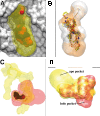Fpocket: an open source platform for ligand pocket detection
- PMID: 19486540
- PMCID: PMC2700099
- DOI: 10.1186/1471-2105-10-168
Fpocket: an open source platform for ligand pocket detection
Abstract
Background: Virtual screening methods start to be well established as effective approaches to identify hits, candidates and leads for drug discovery research. Among those, structure based virtual screening (SBVS) approaches aim at docking collections of small compounds in the target structure to identify potent compounds. For SBVS, the identification of candidate pockets in protein structures is a key feature, and the recent years have seen increasing interest in developing methods for pocket and cavity detection on protein surfaces.
Results: Fpocket is an open source pocket detection package based on Voronoi tessellation and alpha spheres built on top of the publicly available package Qhull. The modular source code is organised around a central library of functions, a basis for three main programs: (i) Fpocket, to perform pocket identification, (ii) Tpocket, to organise pocket detection benchmarking on a set of known protein-ligand complexes, and (iii) Dpocket, to collect pocket descriptor values on a set of proteins. Fpocket is written in the C programming language, which makes it a platform well suited for the scientific community willing to develop new scoring functions and extract various pocket descriptors on a large scale level. Fpocket 1.0, relying on a simple scoring function, is able to detect 94% and 92% of the pockets within the best three ranked pockets from the holo and apo proteins respectively, outperforming the standards of the field, while being faster.
Conclusion: Fpocket provides a rapid, open source and stable basis for further developments related to protein pocket detection, efficient pocket descriptor extraction, or drugablity prediction purposes. Fpocket is freely available under the GNU GPL license at http://fpocket.sourceforge.net.
Figures



Similar articles
-
fpocket: online tools for protein ensemble pocket detection and tracking.Nucleic Acids Res. 2010 Jul;38(Web Server issue):W582-9. doi: 10.1093/nar/gkq383. Epub 2010 May 16. Nucleic Acids Res. 2010. PMID: 20478829 Free PMC article.
-
Large-scale comparison of four binding site detection algorithms.J Chem Inf Model. 2010 Dec 27;50(12):2191-200. doi: 10.1021/ci1000289. Epub 2010 Sep 9. J Chem Inf Model. 2010. PMID: 20828173
-
MDpocket: open-source cavity detection and characterization on molecular dynamics trajectories.Bioinformatics. 2011 Dec 1;27(23):3276-85. doi: 10.1093/bioinformatics/btr550. Epub 2011 Oct 3. Bioinformatics. 2011. PMID: 21967761
-
Free resources to assist structure-based virtual ligand screening experiments.Curr Protein Pept Sci. 2007 Aug;8(4):381-411. doi: 10.2174/138920307781369391. Curr Protein Pept Sci. 2007. PMID: 17696871 Review.
-
[Development and validation of programs for ligand-binding-pocket search].Yakugaku Zasshi. 2011;131(10):1429-35. doi: 10.1248/yakushi.131.1429. Yakugaku Zasshi. 2011. PMID: 21963969 Review. Japanese.
Cited by
-
Phosphorylation of the retinoic acid receptor alpha induces a mechanical allosteric regulation and changes in internal dynamics.PLoS Comput Biol. 2013 Apr;9(4):e1003012. doi: 10.1371/journal.pcbi.1003012. Epub 2013 Apr 18. PLoS Comput Biol. 2013. PMID: 23637584 Free PMC article.
-
A new method for network bioinformatics identifies novel drug targets for mucinous ovarian carcinoma.NAR Genom Bioinform. 2024 Aug 24;6(3):lqae096. doi: 10.1093/nargab/lqae096. eCollection 2024 Sep. NAR Genom Bioinform. 2024. PMID: 39184376 Free PMC article.
-
The Critical Role Of VP1 In Forming The Necessary Cavities For Receptor-mediated Entry Of FMDV To The Host Cell.Sci Rep. 2016 Jun 2;6:27140. doi: 10.1038/srep27140. Sci Rep. 2016. PMID: 27249937 Free PMC article.
-
Allosteric modulation of the CXCR4:CXCL12 axis by targeting receptor nanoclustering via the TMV-TMVI domain.Elife. 2024 Sep 9;13:RP93968. doi: 10.7554/eLife.93968. Elife. 2024. PMID: 39248648 Free PMC article.
-
Choosing the Optimal Rigid Receptor for Docking and Scoring in the CSAR 2013/2014 Experiment.J Chem Inf Model. 2016 Jun 27;56(6):1004-12. doi: 10.1021/acs.jcim.5b00338. Epub 2015 Aug 7. J Chem Inf Model. 2016. PMID: 26222931 Free PMC article.
References
-
- Manly CJ, Chandrasekhar J, Ochterski JW, Hammer JD, Warfield BB. Strategies and tactics for optimizing the Hit-to-Lead process and beyond-A computational chemistry perspective. Drug Discov Today. 2008;13:99–109. - PubMed
-
- Villoutreix BO, Bastard K, Sperandio O, Fahraeus R, Poyet JL, Calvo F, Déprez B, Miteva MA. In silico-in vitro screening of protein-protein interactions: towards the next generation of therapeutics. Curr Pharm Biotechnol. 2008;9:103–22. - PubMed
-
- Levitt DG, Banaszak LJ. POCKET: a computer graphics method for identifying and displaying protein cavities and their surrounding amino acids. J Mol Graph. 1992;10:229–34. - PubMed
-
- Delaney JS. Finding and filling protein cavities using cellular logic operations. J Mol Graph. 1992;10:174–7. - PubMed
MeSH terms
Substances
LinkOut - more resources
Full Text Sources
Other Literature Sources
Molecular Biology Databases

